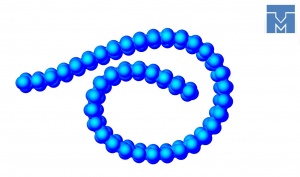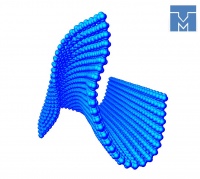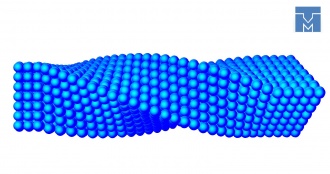V-model
Содержание
Introduction
The article is based on the oncoming paper V.A. Kuzkin and I.E. Asonov "Vector-based model of elastic bonds for DEM simulation of solids".
Discrete Element Method (DEM) is widely used for computer simulation of granular materials both solid and free-flowing. In powders and other free-flowing media interactions between particles usually include contact forces, dry and viscous friction, cohesion, electrostatic forces etc. For simulation of solids particles are additionally connected by so-called bonds [1], [2]. In general case bond transmits both forces and moments acting between particles. They are responsible for stability, elasticity, strength and other intrinsic properties that distinguish solids from free-flowing materials. The bonds may have different physical meaning. On the one hand they can specify the law of interaction between different parts of one material represented by the particles. On the other hand bonds can be considered as a model of some additional glue-like or cement-like material, connecting particles.
In practice models allowing to represent forces and moments, acting between particles, as a function of characteristics of particle motion (linear and angular velocities, rotational matrixes, quaternions, etc.) are required. According to the review presented in paper [2] only several models presented in literature describe all possible kinds of deformation of the bond. Bonded-particle model (BPM) was proposed in paper [1] for simulation of rocks. The BPM model is widely used in literature for simulation of deformation and fracture of solids in both two and three dimensions. Several drawbacks of BPM model, in particular, in the case of coexistence of bending and torsion of the bond, are discussed in paper [2]. It is noted that the main reason for the drawbacks is incremental algorithm used in the framework of BPM model. Another approach based on decomposition of relative rotation of particles is proposed in paper [2]. Forces and moments are represented as functions of angles describing relative turn of the particles. It was shown that method [2] is more accurate than incremental procedure of BPM model. However in the framework of model [2] potential energy of the bond and its relation to forces and torques are not considered. Though the expression for potential energy is not required for DEM simulations it is still very important. It is required for control of energy conservation and construction of nonlinear elastic force laws. The approach proposed in paper [2] does not guarantee that the forces and moments caused by the bond are conservative. Note that any model for an elastic bond should be perfectly conservative.
Also let us note the model recently development by DEM-sloutions Ltd.. It was proposed to use Timoshenko beam as a model of the bond connecting particle. Though the model has clear physical meaning it is also not the panacea. In particular, it is not straightforward how to implement this model in the case of finite rotations of the particles.
There are also some other physical drawbacks of the existing bond models that will be highlighted in the paper. Let us summarize them:
- energy conservation is not guaranteed (BPM, Wang's model)
- non close-packed lattices, rods and shells can not be modeled as they are unstable (BPM)
- bond connects centers of the particles. In contrast, in reality particles are usually glued by their surfaces. The difference can be crucial, especially for a short bonds (BPM, Wang's model, Timoshenko beam)
- large rotations of the particles as well as rigid body rotations of all specimen can not be considered (Timoshenko beam)
- low accuracy in the case of short bonds (Timoshenko beam)
- generalization for the case of large nonlinear elastic deformations of the bond is not straightforward. The generalization can be crucial for polymer (for example, rubber) bonds (BPM, Wang's model, Timoshenko beam)
V-model
The V-model is based on the combination of approaches proposed in works of P.A. Zhilin, E.A. Ivanova, A.M. Krivtsov, N.F. Morozov [3], [4] and works of M.P. Allen [5], S.L Price. The idea of the model is to introduce potential energy of interactions between two bonded particles as a function of particles orientations. The potential energy describes all possible kinds of deformation of the bond: tension/compression, shear, bending and torsion.
Detailed description of the model and procedures for parameters calibration will be given in the paper. Here let us show some results obtained using V-model.
Advantages of V-model
Let us summarize advantages of V-model:
* applicable in the case of large turns of the particles * conservation of energy (bonds are perfectly elastic) * the bond has longitudinal, shear, bending and torsional stiffnesses that can be set independently * any non close packed structure, rods and shells can be modeled (see figures above) * forces and moments are calculated at the present moment as a functions of particles orientations (more accurate integration of motion equations then in the case of incremental algorithm used for BPM) * description of bonds of any length/thickness ratio. It is shown that in the case of small deformations the behavior of the bond can fit the behavior of Bernulli-Euler rod or Timosheko rod or short cylinder connecting particles (depending on length/thickness ratio) * simple analytical expressions connecting parameters of V-model with geometrical and mechanical characteristics of the bond * bonds can connect points inside the particles or lying on particles surfaces (not only particle centers) * the model can be easily generalized in order to describe nonlinear elastic behavior of the bond * fracture criterion used in BPM can be used in couple with V-model
History and acknowledgements
The idea underlining V-model was first formulated on the paper by Vitaly Kuzkin during communication with Michael Wolff in Technical University of Hamburg (March, 2011). The first formulation was very simple and coarse, but it works! The results of some test simulations were presented by Vitaly Kuzkin on APM 2011 conference (July, 2011). At the present moment V-model is much more flexible and physically meaningful than its first version. Now it is developed jointly by Vitaly Kuzkin and Igor Asonov.
The authors are deeply grateful to Michael Wolff, Prof. Anton Krivtsov, Prof. Stephan Heinrich and Dr. Sergiy Antonyuk.
References
- ↑ 1,0 1,1 Potyondy D.O., Cundall P.A. Abonded-particle model for rock // Int. J. of Rock Mech. & Min. Sc., 41, (2004) pp. 1329–1364
- ↑ 2,0 2,1 2,2 2,3 2,4 2,5 2,6 Wang Y. A new algorithm to model the dynamics of 3-D bonded rigid bodies with rotations // Acta Geotechnica, 4, (2009), pp. 117–127
- ↑ E.A. Ivanova, A. M. Krivtsov, N. F. Morozov, A. D. Firsova. Decsription of crystal particle packing considering moment interactions // Mechanics of Solids. 2003. Vol. 38. No 4, pp. 101-117.
- ↑ E. A. Ivanova, A. M. Krivtsov, N. F. Morozov, Derivation of macroscopic relations of the elasticity of complex crystal lattices taking into account the moment interactions at the microlevel // J. App. Math. and Mech.,Vol. 71, Is. 4, 2007, pp. 543-561.
- ↑ M.P. Allen, D.J. Tildesley, Computer simulation of liquids, Clarendon Press, Oxford, 1987, p. 385.


